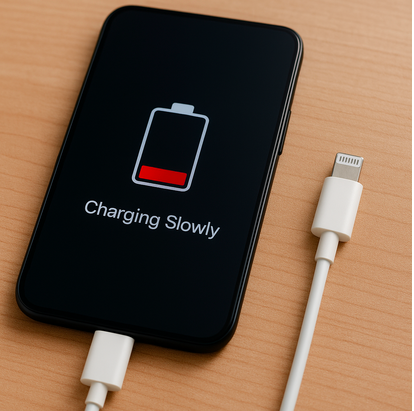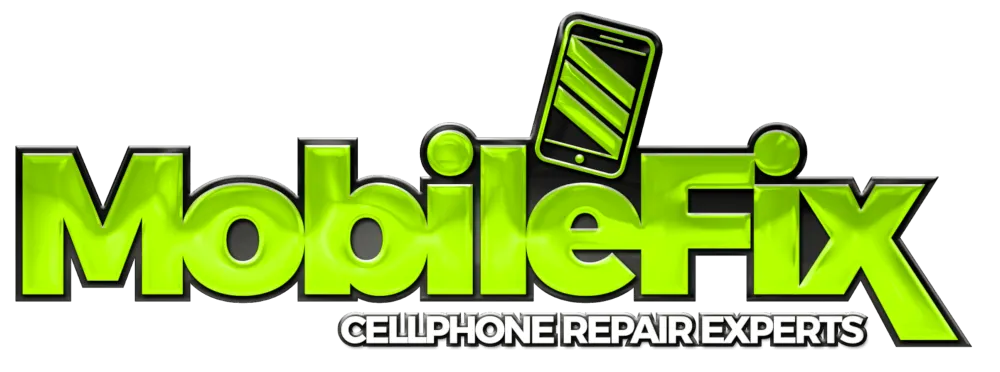Written by: James Whitaker

If your phone takes forever to charge, you’re not alone. Whether you’re using a USB-C or Lightning cable, slow charging can be frustrating—especially when you need your phone powered up fast. Charging speed depends on more than just your cable; it’s affected by your power source, adapter quality, battery condition, and even background apps.
At Mobile Fix Experts, our technicians see these problems daily—customers walk in with phones that refuse to charge quickly, even with brand-new accessories. This guide breaks down why slow charging happens, how USB-C differs from Lightning, and the best ways to fix it safely.
Section 1: Understanding Charging Technology
The Evolution of Phone Charging
Back in the early smartphone days, charging cables were mostly micro-USB. Then Apple introduced the Lightning connector, known for its compact design and reversible plug. Later, Android manufacturers and Apple’s newer iPhones adopted USB-C, a universal standard that allows faster charging and higher data transfer speeds.
Despite being more powerful, USB-C and Lightning each have unique behaviors. Knowing how they work helps you diagnose slow-charging issues accurately.
USB-C vs. Lightning: Key Differences
| Feature | USB-C | Lightning |
|---|---|---|
| Speed | Up to 240W (depending on cable/adaptor) | Around 12W max on older models |
| Compatibility | Works with most Android phones, tablets, laptops | Only works with Apple devices |
| Durability | Thicker pins, symmetrical plug | Smaller, more prone to wear |
| Data Transfer | Faster transfer rates | Slower, proprietary connection |
In short, USB-C supports faster and more flexible charging, while Lightning is limited by Apple’s older hardware restrictions. But even the fastest cable can’t help if the phone or adapter has issues.
Section 2: Common Causes of Slow Charging
Let’s explore why your phone charges slowly—no matter which cable you use.
1. Weak Power Source
Plugging into a computer port or low-amp charger limits power delivery. USB 2.0 ports output about 0.5 amps—barely enough for a modern smartphone. Always use a wall adapter rated at at least 18W for fast charging.
If you’re unsure which power source is best, our technicians at Repair a Device can run a quick diagnostic and confirm whether your adapter or port is delivering enough power.
2. Damaged or Poor-Quality Cable
Cables wear out over time—bending, fraying, or losing conductivity. Low-quality third-party cables often lack proper shielding, causing voltage drops and overheating. Try replacing your cable with an MFi-certified Lightning cable or a USB-C cable rated for Power Delivery (PD).
3. Dirty Charging Port
Lint, dust, and moisture can block contact points, interrupting power flow. A clogged port can make your phone charge slowly or stop entirely. Use a soft brush or compressed air to gently clean it—or visit Mobile Fix Experts for a safe cleaning service.
4. Background Apps Draining Power
Apps running in the background—especially GPS, streaming, or messaging apps—can consume energy faster than the charger can deliver it. Always close unused apps or enable Battery Saver Mode while charging.
5. Battery Health Decline
Batteries degrade over time. If your phone is more than two years old, reduced charging speed might indicate battery wear. Visit Mobile Fix Experts to test and replace your battery with premium-grade parts.
Section 3: Diagnosing USB-C vs. Lightning Issues
For USB-C Devices
USB-C supports several fast-charging protocols—Power Delivery (PD), Quick Charge, and Adaptive Fast Charging. Slow performance could mean the phone or adapter isn’t negotiating properly.
Try these steps:
- Use the original adapter that came with your device.
- Check if your phone displays “Fast Charging” or “Super Fast Charging.” If not, the adapter may be incompatible.
- Avoid charging from laptops or car USB ports—they often output lower wattage.
For Lightning Devices
Older iPhones using Lightning ports rely on USB-A adapters (5W) unless upgraded to USB-C to Lightning (18W or higher). If your iPhone charges slowly:
- Use Apple’s USB-C to Lightning cable and an 18W+ adapter.
- Check your Battery Health in Settings → Battery → Battery Health & Charging.
- Replace any damaged Lightning cables immediately—worn pins can disrupt current flow.
You can also visit our Buy a Device or Sell a Device pages if you’re considering upgrading to a newer model with USB-C support for faster charging speeds.
Section 4: Proven Fixes for Slow Charging
Step 1: Clean Your Charging Port Safely
Use a flashlight to check for dust or debris. If you see buildup, power off your device and gently clean with a wooden toothpick or dry brush. Avoid sharp metal tools—they can damage the port.
Step 2: Try a Certified Cable and Adapter
Use only certified accessories designed for your phone brand. Avoid cheap knockoffs that can cause power surges or battery damage.
Step 3: Avoid Using the Phone While Charging
Gaming, streaming, or scrolling during charging increases temperature and slows down power absorption. Give your device a break to charge faster.
Step 4: Enable Low Power Mode
Activating Low Power or Battery Saver mode reduces background processes, improving charging efficiency by up to 20%.
Step 5: Update Software Regularly
Firmware updates often include charging and power-management improvements. Keeping your system current prevents bugs that cause charging glitches.
Step 6: Replace a Faulty Battery or Port
If all else fails, hardware may be to blame. A faulty charging port or worn-out battery can restrict power flow. Our technicians at Mobile Fix Experts specialize in diagnosing and replacing charging components safely and affordably.
Section 5: USB-C Adoption and the Future of Charging
The tech world is rapidly shifting toward USB-C as the universal standard. Apple began transitioning with its latest iPhone models, marking the end of the Lightning era. USB-C enables:
- Faster charging and higher power delivery
- One-cable compatibility across laptops, tablets, and phones
- Improved data transfer and accessory support
However, the transition also means users need to watch out for cheap USB-C cables that can damage devices. Quality always matters—whether it’s charging speed, safety, or battery lifespan.
When in doubt, visit your nearest Mobile Fix Experts location for a quick assessment and expert recommendations tailored to your device.
Section 6: Preventive Maintenance Tips
Keep your device charging smoothly with these long-term habits:
- Store cables properly—avoid twisting or sharp bends.
- Unplug chargers once your device reaches 100% to prevent heat buildup.
- Use surge protectors for wall charging to prevent voltage spikes.
- Keep software and apps updated regularly.
- Schedule periodic device health checks at Mobile Fix Experts.
These habits ensure consistent performance and extend your phone’s overall lifespan.
Section 7: When to Visit a Repair Shop
Sometimes, slow charging is more than a minor glitch. Seek professional help if:
- Your phone doesn’t recognize the charger at all.
- The charging cable feels loose in the port.
- The phone heats up unusually during charging.
- Battery percentage drops while plugged in.
Our skilled technicians at Mobile Fix Experts can diagnose and fix charging issues quickly—usually within the same day. Whether it’s a simple port cleaning or a full replacement, we’ll ensure your phone regains optimal charging speed safely.
Section 8: FAQs
Q1: Why does my phone charge faster with one cable than another?
Because different cables support different wattage levels and data standards. Always choose one that matches your phone’s charging protocol.
Q2: Is it safe to leave my phone charging overnight?
Modern phones stop charging once full, but continuous heat exposure can shorten battery life. Unplugging after 100% is best.
Q3: Can using a laptop to charge my phone damage it?
No, but it will charge slower since most computer USB ports supply limited power output.
Q4: How do I know if my charger supports fast charging?
Check the output rating on your adapter. Anything labeled 18W or higher usually supports fast charging.
Q5: Should I switch from Lightning to USB-C?
Yes, if your device supports it. USB-C is faster, more reliable, and widely compatible across multiple devices.
Disclaimer
The information provided in this blog is for educational purposes only. It does not substitute professional repair or diagnostic advice. For accurate assessment and safe solutions, please visit Mobile Fix Experts or contact our technicians through the Repair a Device page.
